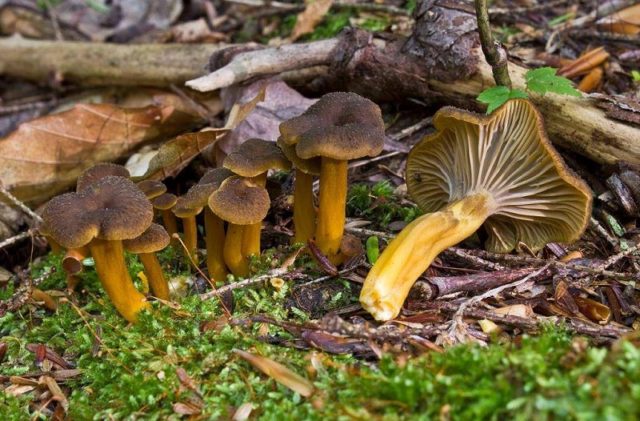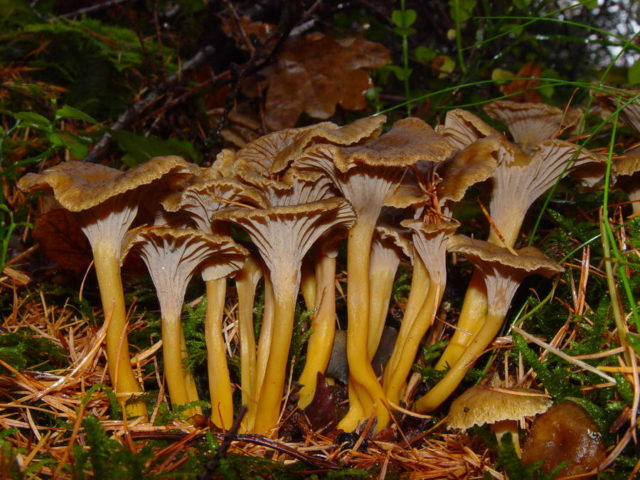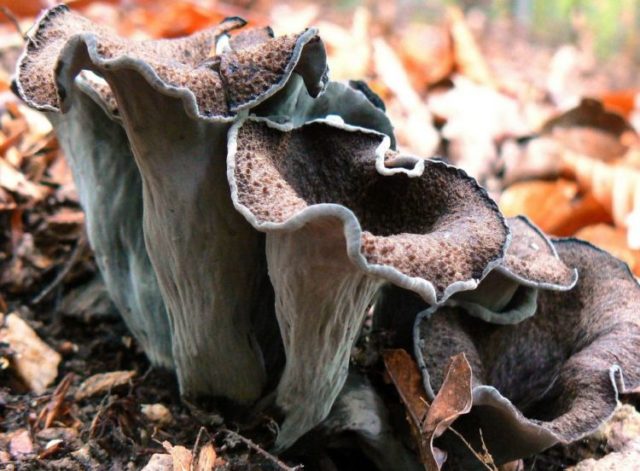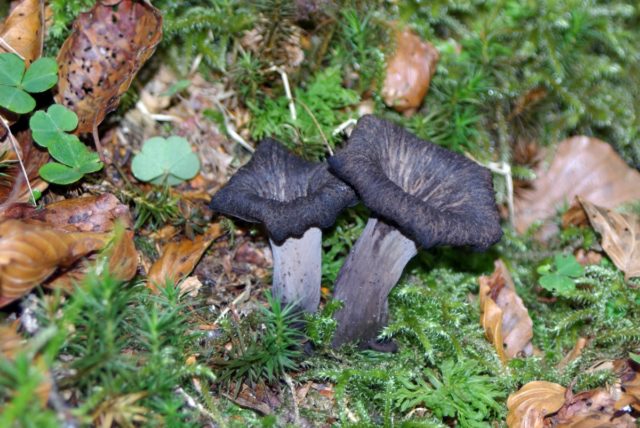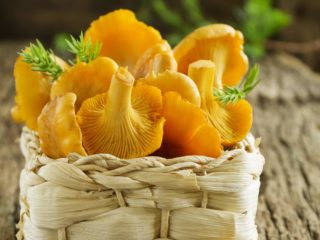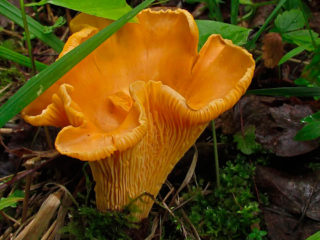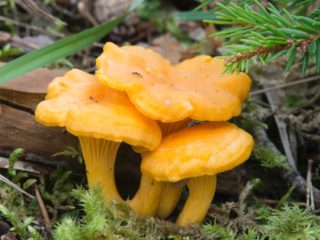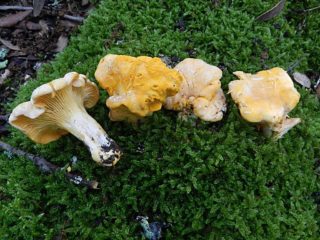Content
- 1 Where tubular (funnel) chanterelles grow
- 2 What tubular (funnel) chanterelles look like
- 3 Is it possible to eat tubular (funnel) chanterelles
- 4 Taste qualities of funnel chanterelles
- 5 The benefits of tubular (funnel) chanterelles
- 6 Collection rules
- 7 False twins of tubular (funnel-shaped) chanterelles
- 8 Recipes for tubular (funnel-shaped) chanterelles
- 9 Conclusion
Despite the fact that the tubular chanterelle (funnel-shaped) is not widespread in the Russian climate, true mushroom pickers are increasingly interested in this species and its properties. And it is no coincidence, because the tubular representative of the Chanterelle family is considered a mushroom delicacy and is served in fashionable restaurants in Europe.
Where tubular (funnel) chanterelles grow
Tubular, or funnel-shaped, chanterelles prefer moist and acidic soil, so they can often be found near moss. They grow in large clusters, and usually searches should be carried out in mixed or coniferous forests, especially old ones.
What tubular (funnel) chanterelles look like
Tubular (funnel-shaped) chanterelles have a rather unusual appearance. The hat of a young specimen, at first flat and even, begins to curl up with age and becomes like a funnel - hence the second name of this mushroom. Most often, the hat is light gray, maybe almost white. Its edges are heavily curled, but this does not prevent its texture from remaining thin and firm enough. If the funnel-chanterelle representative is healthy, the cap can be straightened without harming it.
The inside of the cap is white and covered with long, deep folds. This pattern descends to the stem of the funnel-shaped (tubular) chanterelle and merges with it. The leg, in turn, is quite hard and strong, despite the fact that it is hollow in the center.
In size, the funnel-shaped variety of the Chanterelle is a small mushroom, the diameter of the cap of which is more than 6 cm, while the leg can be no higher than 5 cm and up to 1 cm in diameter. Tubular (funnel-shaped) chanterelles in the photo:
Is it possible to eat tubular (funnel) chanterelles
Tubular (funnel-shaped) chanterelles are used for food. Moreover, they are very similar in taste to the classic variety: you may not even notice any differences between them. Funnel chanterelles are versatile in preparation - they can be fried, boiled, stewed and pickled. The only problem that can arise in connection with culinary processing is that they easily absorb harmful substances from the atmosphere, so they should be collected exclusively in ecologically clean regions, away from the city.
Taste qualities of funnel chanterelles
These mushrooms are considered delicious not only because of their rarity, but also because of their extraordinary taste. They belong to the second taste category, and, despite all the similarities with ordinary chanterelles, they have a more delicate and delicate taste. The chefs of the funnel-shaped representatives of this mushroom family are mainly cooked, since this method of processing allows not only to preserve, but also to enhance the unusual taste.
The benefits of tubular (funnel) chanterelles
Tubular chanterelles, or funnel-shaped chanterelles (cantharellus tubaeformis) have useful properties similar to common representatives. They are especially good in three ways:
- Tubular (funnel-shaped) chanterelles have rich reserves of vitamin A, which has a beneficial effect on vision: the use of this species even helps to normalize the condition of the mucous membrane of the eye and stabilize eye pressure.Attention! The content of vitamin A is presented among all mushroom varieties in funnel chanterelles.
- Polysaccharides in funnel chanterelles allow you to remove parasites and harmful bacteria from the body. In addition, such a product is able to rid a person of accumulated heavy metals.
- Regular consumption of tubular (funnel-shaped) chanterelles allows you to get rid of liver problems and even helps in the fight against hepatitis, although it is not a panacea for it.
Collection rules
The season for collecting tubular (funnel-shaped) chanterelles begins in August-September and lasts until the onset of winter.
What is important to know when collecting this variety:
- The fungus often hides among the moss, in the grass, and this complicates the search for it.
- Due to the characteristic feature of the tubular (funnel-shaped) chanterelle, to form mycorrhiza and with hard and soft species of trees and conifers, it is worth paying attention to rotten wood, as well as looking for a yellow beauty under pines and spruces.
- The funnel-shaped representatives of the Fox, located in groups, often form the so-called witch's circles.
- In addition, this variety does not need to be checked immediately for the presence of worms: they simply do not exist in it. This is another advantage of tubular (funnel-shaped) chanterelles, among which it is difficult to find undergone and spoiled mushrooms.
False twins of tubular (funnel-shaped) chanterelles
These funnel-shaped chanterelles have quite a few twins, but none of them is poisonous: they are all conditionally edible. Nevertheless, it is necessary to understand the types, since each of them has its own taste and demand in cooking.
The most common twins of the tubular (funnel-shaped) variety of Chanterelle:
- Yellowing chanterelle... It has a more yellow tint, and the reverse side has a smoother surface. You can cook it in the usual way. The harvest season begins in early summer and lasts until mid-autumn;
- Funnel maker gray... It is grayer than the funnel chanterelle and also has a smooth back. The taste of the funnel is much inferior to funnel representatives, therefore it is less often used in cooking;
- Black fox... Firstly, it differs in size - it can be twice as large as funnel. Secondly, it is darker and less pliable. Its texture is harder than that of the funnel-shaped variety, which is why only hats are used in cooking, since the legs are highly rigid.
Recipes for tubular (funnel-shaped) chanterelles
Since tubular (funnel-shaped) chanterelles are quite rare specimens, they are usually eaten immediately, without drying or pickling them for later. They reveal their taste best when cooked, so it is worth considering three recipes that will allow you to enjoy all the subtleties of these mushrooms.
Soup with funnel chanterelles and cauliflower
For cooking you will need:
- 0.3 kg of fresh funnel-shaped chanterelles;
- 0.5 kg of cauliflower;
- 0.2 kg bacon;
- onions and spices - to taste;
- vegetable oil.
Sequence of steps:
- Chop bacon and onion for sautéing.
- Put the bacon in a preheated oil pan, fry it for a couple of minutes over low heat, then add the onion to it and fry it until softened.
- Prepare funnel chanterelles: rinse thoroughly and cut off about 1/3 of their legs.
- Then gently add the mushrooms to the pan and fry everything together for about five minutes.
- Divide the cauliflower into small florets, pour water or stock in a saucepan and cook for about 10 minutes.
- Add the contents of the pan to the saucepan and add more water or broth.
- Cook until boiling.
When serving, herbs should be added to the soup carefully, as they can overpower the delicate taste of mushrooms: you can simply limit yourself to light spices.
Creamy funnel chanterelle strudel
Ingredients:
- 5 sheets of ready-made filo dough;
- 0.3 kg of funnel-shaped chanterelles;
- 0.3 l of 10% cream;
- 1 tbsp. l. flour;
- spices to taste.
First you need to prepare the filling:
- Finely chop the mushrooms and onions and fry them in a pan until the moisture evaporates from the mushrooms.
- Pour cream over the contents of the pan and let simmer for a minute or two, and then remove from heat.
Roll preparation:
- To get a good base, you need to process each layer of dough separately with melted butter.
- Put the mushrooms on a sheet, leaving a distance of about 3 cm at the edges - so that they can be tucked up.
- Fold the edges inward and roll the dough into a roll. It is important to ensure that the filling does not fall out of it.
- Put the strudel on an oiled baking sheet, pierce it in several places with a fork so that the dough can “breathe”, and send the dish to the oven for five minutes at 220 ° C.
- After this time, remove the roll from the oven, grease its surface with cream and send it back to the oven for another 10 - 15 minutes.
Funnel chanterelles with fried potatoes
This is the simplest and most popular recipe for cooking funnel chanterelles.
For cooking you will need:
- 0.3 kg of funnel-shaped chanterelles;
- 0.5 kg of young potatoes;
- 3 cloves of garlic;
- 1 PC. onions;
- vegetable oil, spices - to taste.
Cooking procedure:
- Finely chopped onion and garlic are sautéed in a frying pan.
- At this time, the mushrooms are washed, the potatoes are washed and cut.
- Add the potatoes and mushrooms to the pan when the onions turn transparent.
- Fry everything over low heat under a closed lid for 5 minutes.
- After removing the lid, mix the potatoes with mushrooms and then continue to fry until golden brown, stirring occasionally.
Conclusion
The tubular chanterelle (funnel-shaped) is a rarity in the Russian climate, since this yellow beauty needs more moist soils to grow. But all the difficulties associated with the collection are paid off by the exquisite taste of this mushroom delicacy.
